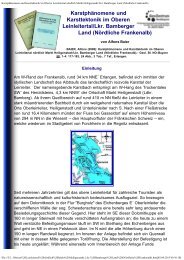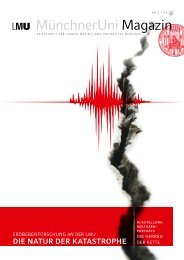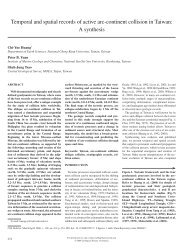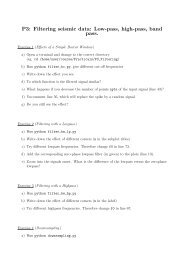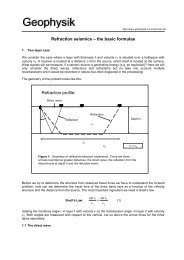- Seite 1 und 2:
Seismologie - Seismik
- Seite 3 und 4:
Geschichte der Seismologie/Seismik
- Seite 5 und 6:
Geschichte der Seismologie/Seismik
- Seite 7 und 8:
Geschichte der Seismologie/Seismik
- Seite 9 und 10:
Geschichte der Seismologie/Seismik
- Seite 11 und 12:
Geschichte der Seismologie/Seismik
- Seite 13 und 14:
Geschichte der Seismologie/Seismik
- Seite 15 und 16:
Geschichte der Seismologie/Seismik
- Seite 17 und 18:
Geschichte der Seismologie/Seismik
- Seite 19 und 20:
Geschichte der Seismologie/Seismik
- Seite 21 und 22:
Geschichte der Seismologie/Seismik
- Seite 23 und 24:
Geschichte der Seismologie/Seismik
- Seite 25 und 26:
Geschichte der Seismologie/Seismik
- Seite 27 und 28:
Geschichte der Seismologie/Seismik
- Seite 29 und 30:
• Elastizitätstheorie • Wellen
- Seite 31 und 32:
Elastizitätstheorie Wirkung von Sp
- Seite 33 und 34:
Elastizitätstheorie τ Wirkung von
- Seite 35 und 36:
Elastizitätstheorie τ ... Rotatio
- Seite 37 und 38:
Elastizitätstheorie und Deformatio
- Seite 39 und 40:
Elastizitätstheorie τ und Deforma
- Seite 41 und 42:
Elastizitätstheorie Grundarten der
- Seite 43 und 44:
Elastizitätstheorie Grundarten der
- Seite 45 und 46:
Elastizitätstheorie Grundarten der
- Seite 47 und 48:
Elastizitätstheorie Grundarten der
- Seite 49 und 50:
Elastizitätstheorie Grundarten der
- Seite 51 und 52:
Elastizitätstheorie Grundarten der
- Seite 53 und 54:
Elastizitätstheorie Grundarten der
- Seite 55 und 56:
Elastizitätstheorie Grundarten der
- Seite 57 und 58:
Elastizitätstheorie Grundarten der
- Seite 59 und 60:
Elastizitätstheorie Grundarten der
- Seite 61 und 62:
Elastizitätstheorie Gültigkeit de
- Seite 63 und 64:
Elastizitätstheorie
- Seite 65 und 66:
Zeit Seismische Wellen Definition G
- Seite 67 und 68:
Zeit Seismische Wellen Definition G
- Seite 69 und 70:
Zeit Seismische Wellen Definition G
- Seite 71 und 72:
Seismische Wellen Phasengeschwindig
- Seite 73 und 74:
Seismische Wellen Gruppengeschwindi
- Seite 75 und 76:
Seismische Wellen
- Seite 77 und 78:
Seismische Wellen ρ∂ 2 tui = fi
- Seite 79 und 80:
Seismische Wellen ρ∂ 2 tui = fi
- Seite 81 und 82:
Seismische Wellen durch die Definit
- Seite 83 und 84:
Seismische Wellen durch die Definit
- Seite 85 und 86:
Seismische Wellen Seismische Geschw
- Seite 87 und 88:
Seismische Wellen Nave-Drake (Sedim
- Seite 89 und 90:
Seismische Wellen Wellenfronten - S
- Seite 91 und 92:
Wellenfronten - Strahlen: Seismisch
- Seite 93 und 94:
Seismische Wellen Strahlentheorie:
- Seite 95 und 96:
Seismische Wellen Strahlentheorie:
- Seite 97 und 98:
Seismische Wellen Polarisation (Tei
- Seite 99 und 100:
Seismische Wellen Absorption (Dämp
- Seite 101 und 102:
Seismische Wellen Absorption (Streu
- Seite 103 und 104:
Seismische Wellen Mantel äusserer
- Seite 105 und 106:
Das Magnetfeld der Erde
- Seite 107 und 108:
Seismische Wellen Mantel äusserer
- Seite 109 und 110:
Seismische Wellen
- Seite 111 und 112:
Seismische Wellen
- Seite 113 und 114:
Seismische Wellen
- Seite 115 und 116:
Seismische Wellen
- Seite 117 und 118:
Seismische Wellen
- Seite 119 und 120:
Describing the Seismic Data Seismom
- Seite 121 und 122:
Sensorik
- Seite 123 und 124:
Sensorik
- Seite 125 und 126:
Sensorik 0 -0,2 0 Fig. 5.2 Input si
- Seite 127 und 128:
Sensorik 0 -0,2 0 Fig. 5.4 Original
- Seite 129 und 130:
Sensorik 0 -0,2 0 Fig. 5.5 Original
- Seite 131 und 132:
Sensorik Consequence of violation:
- Seite 133 und 134:
Sensorik
- Seite 135 und 136:
Sensorik
- Seite 137 und 138:
Influence of recording system Fig.
- Seite 139 und 140:
Sensorik Block diagram Fig. 1.10 Bl
- Seite 141 und 142:
The seismometer x0 Fig. 4.1 Model o
- Seite 143 und 144:
Acting forces • The inertia of th
- Seite 145 und 146:
Acting forces • The inertia of th
- Seite 147 und 148:
Equilibrium conditions
- Seite 149 und 150:
Since Equilibrium conditions
- Seite 151 und 152:
Equilibrium conditions Since With a
- Seite 153 und 154:
Underdamped case (ω0 >ε ), result
- Seite 155 und 156:
Seismologie
- Seite 157 und 158:
Aufbau der Seismogramme Häufigkeit
- Seite 159 und 160:
Seismologie WEBGEO
- Seite 161 und 162:
Die Erde bebt - Was passiert?
- Seite 163 und 164:
Die Erde bebt - Was passiert?
- Seite 165 und 166:
Die Erde bebt - Was passiert?
- Seite 167 und 168:
Die Erde bebt - Was passiert?
- Seite 169 und 170:
Die Erde bebt - Was passiert?
- Seite 171 und 172:
Aufbau der Seismogramme lokales Ere
- Seite 173 und 174:
Aufbau der Seismogramme lokales Ere
- Seite 175 und 176:
Aufbau der Seismogramme lokales Ere
- Seite 177 und 178:
Aufbau der Seismogramme lokales Ere
- Seite 179 und 180:
Aufbau der Seismogramme
- Seite 181 und 182:
Aufbau der Seismogramme
- Seite 183 und 184:
Aufbau der Seismogramme Einteilung
- Seite 185 und 186:
Aufbau der Seismogramme Einteilung
- Seite 187 und 188:
Aufbau der Seismogramme Einteilung
- Seite 189 und 190:
Aufbau der Seismogramme
- Seite 191 und 192:
Aufbau der Seismogramme
- Seite 193 und 194:
Aufbau der Seismogramme Einteilung
- Seite 195 und 196:
Aufbau der Seismogramme Einteilung
- Seite 197 und 198:
Aufbau der Seismogramme Woher resul
- Seite 199 und 200:
Aufbau der Seismogramme Lokale & re
- Seite 201 und 202:
Aufbau der Seismogramme Lokale & re
- Seite 203 und 204:
Aufbau der Seismogramme Lokale & re
- Seite 205 und 206:
Aufbau der Seismogramme Lokale & re
- Seite 207 und 208:
Aufbau der Seismogramme Phasenkonve
- Seite 209 und 210:
Aufbau der Seismogramme Phasenkonve
- Seite 211 und 212:
Aufbau der Seismogramme Phasenkonve
- Seite 213 und 214:
Aufbau der Seismogramme Phasenkonve
- Seite 215 und 216:
Aufbau der Seismogramme Phasenkonve
- Seite 217 und 218:
Aufbau der Seismogramme Phasenkonve
- Seite 219 und 220:
Aufbau der Seismogramme Lokale & re
- Seite 221 und 222:
Aufbau der Seismogramme teleseismis
- Seite 223 und 224:
Aufbau der Seismogramme teleseismis
- Seite 225 und 226:
Aufbau der Seismogramme teleseismis
- Seite 227 und 228:
Aufbau der Seismogramme Phasenkonve
- Seite 229 und 230:
Aufbau der Seismogramme Phasenkonve
- Seite 231 und 232:
Aufbau der Seismogramme
- Seite 233 und 234:
Aufbau der Seismogramme teleseismis
- Seite 235 und 236:
Aufbau der Seismogramme teleseismis
- Seite 237 und 238:
Und nun? Die Ausbreitung seismische
- Seite 239 und 240:
Und nun? Die Ausbreitung seismische
- Seite 241 und 242:
Magnitude 9.0 NEAR THE EAST COAST O
- Seite 243 und 244:
Magnitude 9.0 NEAR THE EAST COAST O
- Seite 245 und 246:
Mögliche große Erdbeben 132
- Seite 248 und 249:
Historical Seismicity in Bavaria (1
- Seite 250 und 251:
Ereignis vom 15.07.2009
- Seite 252 und 253:
Stationsnetz Hochstaufen 1982: -30k
- Seite 254 und 255:
Seismizität (Ml ≥ 0.3) - Regen (
- Seite 256 und 257:
Modellierung des Regeneinflusses na
- Seite 258 und 259:
Seismizität Unterhaching gefühlte
- Seite 260 und 261:
Seismizität Unterhaching
- Seite 262 und 263:
Seismizität Unterhaching Relokalis
- Seite 264 und 265:
Geothermie in der Bayerischen Molas
- Seite 266 und 267:
German Task Force 2006 SCIENCE!!!
- Seite 268 und 269:
Auswertung der Seismogramme “...
- Seite 270:
Auswertung der Seismogramme
- Seite 273 und 274:
Auswertung der Seismogramme Einzels
- Seite 275 und 276:
Auswertung der Seismogramme Einzels
- Seite 277 und 278:
Auswertung der Seismogramme Einzels
- Seite 279 und 280:
Auswertung der Seismogramme Einzels
- Seite 281 und 282:
Auswertung der Seismogramme Einzels
- Seite 283 und 284:
Auswertung der Seismogramme Einzels
- Seite 285 und 286:
Auswertung der Seismogramme Einzels
- Seite 287 und 288:
Auswertung der Seismogramme Einzels
- Seite 289 und 290:
Auswertung der Seismogramme seismis
- Seite 291 und 292:
Auswertung der Seismogramme seismis
- Seite 293 und 294:
Auswertung der Seismogramme seismis
- Seite 295 und 296:
Auswertung der Seismogramme seismis
- Seite 297 und 298:
Auswertung der Seismogramme seismis
- Seite 299 und 300:
Auswertung der Seismogramme seismis
- Seite 301 und 302:
Auswertung der Seismogramme seismis
- Seite 303 und 304:
Auswertung der Seismogramme seismis
- Seite 305 und 306:
Auswertung der Seismogramme seismis
- Seite 307 und 308:
seismisches Netzwerk - Lokalisieren
- Seite 309 und 310:
Auswertung der Seismogramme seismis
- Seite 311 und 312:
Auswertung der Seismogramme seismis
- Seite 313 und 314:
Auswertung der Seismogramme seismis
- Seite 315 und 316:
Auswertung der Seismogramme seismis
- Seite 317 und 318:
Auswertung der Seismogramme seismis
- Seite 319 und 320:
Auswertung der Seismogramme seismis
- Seite 321 und 322:
Auswertung der Seismogramme seismis
- Seite 323 und 324:
Auswertung der Seismogramme seismis
- Seite 325 und 326:
Auswertung der Seismogramme seismis
- Seite 327 und 328:
Auswertung der Seismogramme seismis
- Seite 329 und 330:
Auswertung der Seismogramme seismis
- Seite 331 und 332:
Auswertung der Seismogramme seismis
- Seite 333 und 334:
Auswertung der Seismogramme seismis
- Seite 335 und 336:
Auswertung der Seismogramme seismis
- Seite 337 und 338:
Auswertung der Seismogramme seismis
- Seite 339 und 340:
Auswertung der Seismogramme seismis
- Seite 341 und 342:
Auswertung der Seismogramme seismis
- Seite 343 und 344:
Auswertung der Seismogramme seismis
- Seite 345 und 346:
Auswertung der Seismogramme seismis
- Seite 347 und 348:
Auswertung der Seismogramme seismis
- Seite 349 und 350:
Auswertung der Seismogramme seismis
- Seite 351 und 352: Auswertung der Seismogramme seismis
- Seite 353 und 354: Auswertung der Seismogramme seismis
- Seite 355 und 356: Auswertung der Seismogramme seismis
- Seite 357 und 358: Auswertung der Seismogramme seismis
- Seite 359 und 360: Auswertung der Seismogramme seismis
- Seite 361 und 362: Auswertung der Seismogramme seismis
- Seite 363 und 364: Auswertung der Seismogramme seismis
- Seite 365 und 366: Auswertung der Seismogramme seismis
- Seite 367 und 368: Auswertung der Seismogramme seismis
- Seite 369 und 370: Auswertung der Seismogramme seismis
- Seite 371 und 372: Die Erde bebt - Wozu Seismologie?
- Seite 373 und 374: Auswertung der Seismogramme Gutenbe
- Seite 375 und 376: Auswertung der Seismogramme Omori -
- Seite 377 und 378: Auswertung der Seismogramme Intensi
- Seite 379 und 380: Auswertung der Seismogramme seismis
- Seite 381 und 382: Auswertung der Seismogramme seismis
- Seite 383 und 384: Auswertung der Seismogramme seismis
- Seite 385 und 386: Auswertung der Seismogramme seismis
- Seite 387 und 388: Auswertung der Seismogramme seismis
- Seite 389 und 390: Auswertung der Seismogramme seismis
- Seite 391 und 392: Auswertung der Seismogramme seismis
- Seite 393 und 394: Auswertung der Seismogramme seismis
- Seite 395 und 396: Auswertung der Seismogramme seismis
- Seite 397 und 398: Auswertung der Seismogramme seismis
- Seite 399 und 400: Auswertung der Seismogramme STN DIS
- Seite 401: Auswertung der Seismogramme seismis



